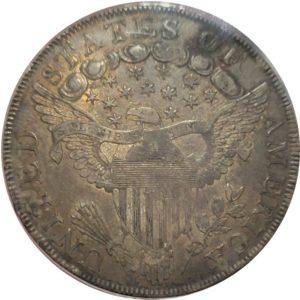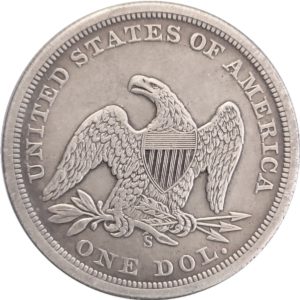1885-CC $1 Morgan Silver Dollar – Carson City Mint.
According to Q. David Bowers in “Silver Dollars & Trade Dollars of the United States: A Complete Encyclopedia” (Wolfeboro, NH: Bowers and Merena Galleries, Inc., 1993):
The Carson City Mint was closed to coinage in November 1885, by which time 228,000 1885-CC dollars had been struck. 200,000 of these were made in January and February and were thus listed as having been produced in fiscal year 1885 July 1, 1884 to June 30, 1885). Additional coins to the amount of 28,000 pieces were struck in August 1885 (which was in fiscal year 1886), giving rise to the old-time theory that there were “1886-CC” dollars, which was not the case. Although 228,000 1885-CC dollars were minted in the year indicated, it is apparent that very few were actually placed into circulation at the time. To suggest that as many as 28,000 were used in the channels of commerce might be an exaggeration, for today worn coins are few and far between and, in fact, are the rarest of all Morgan dollars in circulated grades (not including the Proof-only 1895, of which worn pieces are occasionally seen).
In 1925, numismatist E.S. Thresher reported that despite searching since 1919, he had not been able to find an example in circulation; one of just eight coins absent from his Morgan dollar collection (the others were 1884-CC, 1889-S, 1892, 1893-S, 1894, 1897, and 1899; he had found 1895 and 1903-O).
The desirability of the 1885-CC in the early days is illustrated by these selected market prices from auction sales and dealer listings. As always with branch mint Morgan dollars, the figures were erratic. However, the 1885-CC stands out as one of the most expensive coins in the series: 1890: Unc. $3.40; 1898: Fine $1.60; 1912: VG $11.75; 1914: Unc. $21.00; 1915: “Proof’ $10.00 and VG $8.25; 1916:Unc. $25.50 (a Proof 1895 in the same auction brought all of $1.60!); 1919: Unc. $11.00; 1925: VG $2.35; 1939: Unc. $12.50; and 1941: $5.60.
Uncirculated 1885-CC dollars were considered to be very rare, the creme de la creme of the series, until the 1930s, when John Zug and a few others obtained small quantities from the Cash Room at the Treasury Building in Washington. In 1941-1942, several bags were released, after which the supply seemed to dry up. In 1955, multiple bags came out of hiding in the Treasury Building, and 1885-CC dollars became common on the market, a situation that remained until 1957-1958. During the mid to late 1950s, bags wholesaled for about $1,200 each and retailed for about $1,600.
At the time Harry J. Forman, C.J. Dochkus, J. Grove Loser, John Skubis, Arnold Rosing, and perhaps others as well, actively bought and sold Uncirculated 1885-CC dollars in quantity. In 1958, multiple bags were released in Montana; these were probably from storage at the San Francisco Mint or one of the Federal Reserve facilities.
Additional quantities, probably modest in total, of Uncirculated 1885-CC were turned loose during the Treasury dispersals of 1962-1964, at the end of which 148,285 were held back for later sale by the General Services Administration. These were offered in the 1972-1974 mail bid sales (minimum bid $60). All but 31,569 sold, and those went in the final 1980 sale. The Redfield hoard may have contained as many as 1,000 coins.












